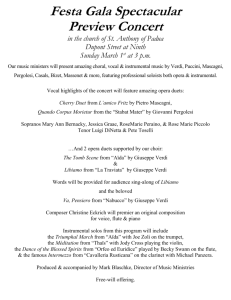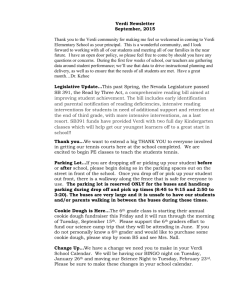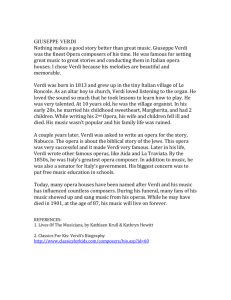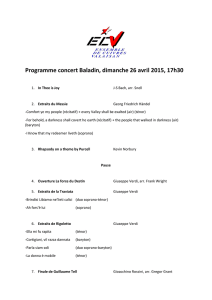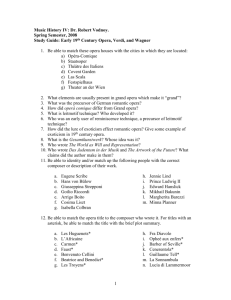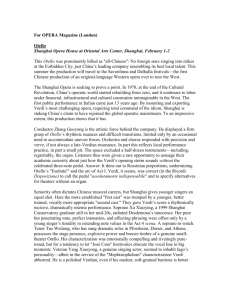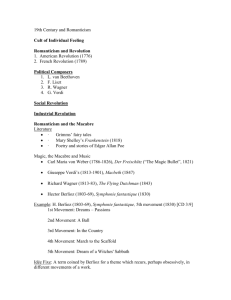Verdi Requiem Bits - National Philharmonic
advertisement
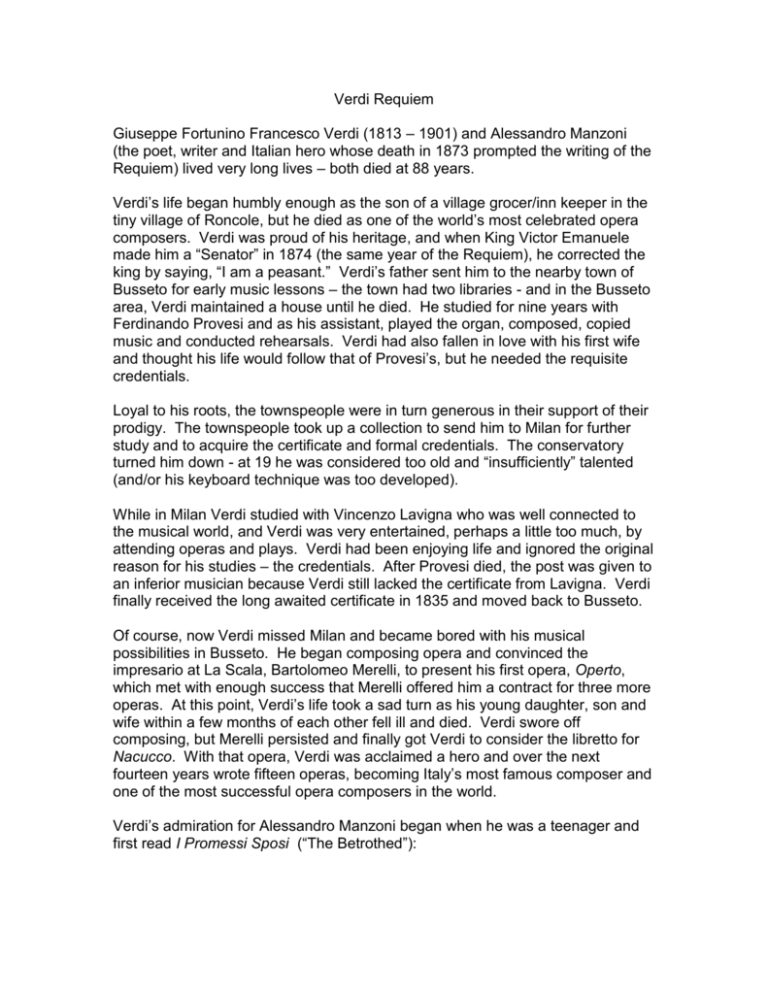
Verdi Requiem Giuseppe Fortunino Francesco Verdi (1813 – 1901) and Alessandro Manzoni (the poet, writer and Italian hero whose death in 1873 prompted the writing of the Requiem) lived very long lives – both died at 88 years. Verdi’s life began humbly enough as the son of a village grocer/inn keeper in the tiny village of Roncole, but he died as one of the world’s most celebrated opera composers. Verdi was proud of his heritage, and when King Victor Emanuele made him a “Senator” in 1874 (the same year of the Requiem), he corrected the king by saying, “I am a peasant.” Verdi’s father sent him to the nearby town of Busseto for early music lessons – the town had two libraries - and in the Busseto area, Verdi maintained a house until he died. He studied for nine years with Ferdinando Provesi and as his assistant, played the organ, composed, copied music and conducted rehearsals. Verdi had also fallen in love with his first wife and thought his life would follow that of Provesi’s, but he needed the requisite credentials. Loyal to his roots, the townspeople were in turn generous in their support of their prodigy. The townspeople took up a collection to send him to Milan for further study and to acquire the certificate and formal credentials. The conservatory turned him down - at 19 he was considered too old and “insufficiently” talented (and/or his keyboard technique was too developed). While in Milan Verdi studied with Vincenzo Lavigna who was well connected to the musical world, and Verdi was very entertained, perhaps a little too much, by attending operas and plays. Verdi had been enjoying life and ignored the original reason for his studies – the credentials. After Provesi died, the post was given to an inferior musician because Verdi still lacked the certificate from Lavigna. Verdi finally received the long awaited certificate in 1835 and moved back to Busseto. Of course, now Verdi missed Milan and became bored with his musical possibilities in Busseto. He began composing opera and convinced the impresario at La Scala, Bartolomeo Merelli, to present his first opera, Operto, which met with enough success that Merelli offered him a contract for three more operas. At this point, Verdi’s life took a sad turn as his young daughter, son and wife within a few months of each other fell ill and died. Verdi swore off composing, but Merelli persisted and finally got Verdi to consider the libretto for Nacucco. With that opera, Verdi was acclaimed a hero and over the next fourteen years wrote fifteen operas, becoming Italy’s most famous composer and one of the most successful opera composers in the world. Verdi’s admiration for Alessandro Manzoni began when he was a teenager and first read I Promessi Sposi (“The Betrothed”): It’s not just a book, it’s a consolation to humanity. I was 16 when I first read it. Since then… if anything my experience of men has made me admire it all the more – because it’s a true book…Oh, if artists could but understand that “true,” there would be no more composers of the future or composers of the past, no puristic, realistic or idealistic painters, no poets classic or romantic, but true poets, true painters, true composers. Verdi fulfilled his vision of an artist’s “true” work when he used his own personal approach to the traditional liturgy of the requiem. Like Berlioz, he began with the language for the Mass for the Dead, but amplified the text with his instinct for drama. Verdi was happily married again and after a prolific period of time when he quickly composed Rigoletto, Il Trovatore and La Traviata, for fifteen years (or twenty in between Aida and Othello), Verdi composed little and seemed quite content to live life as a country squire with his second wife, the singer Giuseppina Strepponi, until a succession of deaths prompted the Requiem. According to David Cairns who wrote about the life of Berlioz (Servitude and Greatness) Verdi, like Berlioz, “was a humanist who retained a poignant regret for his childhood beliefs” who was nevertheless disappointed by the church’s criticisms, including their reaction to the death of Manzoni. Verdi’s wife put it this way: The science, the sophisms, the metaphysical subtleties of the theologians and the learned of all the religions of all the ages strike vainly against the mystery of death. Verdi had already experienced the death of Gioacchino Rossini (1868). Within four days of Rossini’s death, Verdi proposed a collaborative project with thirteen leading Italian composers each composing a section of the Requiem in honor of Rossini to his publisher Ricordi. The Libera me section of the Requiem was composed originally for this project, one that was composed but never performed. Apparently enthusiasm died down as professional rivalries increased and the conductor, Angelo Mariani, lost his enthusiasm for the project (and lost Verdi as a friend when he did). More importantly, Verdi realized it was better not to have to rely on other people for completion of this requiem. The central figure of Italian culture and literature, especially to Verdi and the Milanese, whose writing helped to forge the Italian national identity, Manzoni, had been dying for years. Not only was Manzoni a personal hero to Verdi, he was a national hero, especially during the Milanese revolt against Austria. When the writer and nationalist he idolized finally died, Verdi was disappointed with the obituaries: “No one speaks the way it should. Many words, but none of them deeply felt.” Verdi went “alone and unseen” to Manzoni’s grave and stayed away from the funeral. Verdi had just gotten back his autograph of the Libera me when he heard of Manzoni’s death and proposed to the Mayor of Milan (and again his publisher, Giulio Ricordi) a new Requiem in honor of the man so sacred to the Milanese. Verdi sweetened the deal by offering to conduct himself and pay for the copyists’ fees. Verdi knew he wanted to compose this piece himself. Death was palpable in Verdi’s life (who was now sixty) – not only Rossini and Manzoni, but his own father and father-in-law had just died. Verdi roared in defiance of death in his Requiem. Cairns says, “The Requiem is, among other things, the passionate protest of a man who rebels against the outrage that is death.” Unfortunately life came to imitate art as a contemporary of Verdi’s, Boito, who witnessed Verdi’s death, likewise commented from Verdi’s deathbed: Never have I had such a feeling of hatred against death, of contempt for that mysterious, blind, stupid, triumphant and craven power… He too hated it, for he was the most powerful expression of life that it is possible to imagine. Suffice it to say, Verdi was not going to go quietly into that good night, nor was he finding peace and acceptance in his inevitable mortality. Just as Manzoni’s “true” book shaped and invigorated Verdi’s life, with his Requiem, Verdi gifted mankind with a “true” statement about death imbued with his personal feelings. Noticeably the end of the Requiem, although muted and returning to quieter themes, lacks a sense of serenity, reflecting Verdi’s doubts, his agnosticism. The Requiem begins with ppp and ends with pppp. In between is the massive, powerful fff Dies Irae with its terrifying painting of the Judgment Day, which comprises half of the Requiem. Verdi was very familiar with Berlioz’s Requiem, which in both length and orchestration closely resembles the power of Verdi’s. The first performance of the Messa da Requiem took place May 22, 1874 (first anniversary of Manzoni’s death) at St. Mark’s Church in Milan. With special permission from the Archbishop, female choristers were included in the first performance, but they were hidden behind a screen and dressed in full-length black dresses and mourning veils. Given these restraints and the fact that applause was not allowed in the church, the first performance was successful, but muted. Three days later, a second performance at La Scala Opera House to a capacity crowd was met with exuberance and enthusiasm. The Requiem was a sensation overnight and began to play in European houses, including a spectacular performance at the Royal Albert Hall in London in May 1875, where Verdi himself conducted a chorus of over 1000 and an orchestra of 140. Not all the responses were raves, and many critics disapproved of Verdi’s composing a Mass for the Dead given his agnosticism or found the work too sensational or melodramatic. Verdi took it all in stride: As for the newspapers, does anybody force you to read them?…The day of justice will come, and it is a great pleasure for the artist, a supreme pleasure, to be able to say: ‘Imbeciles, you were wrong!’ The Verdi Requiem has a history of famous performances, including the Defiant Requiem at the concentration camp, Terezin or Theresienstadt. A Romanianborn Czech conductor, Rafael Schaecter, with one score of the Verdi Requiem and a voluntary chorus of 150 gave 16 performances between September 1943 and June 1944. The Nazis made a notorious propaganda film from one of the performances to show how “humanely” the Jews were being treated. The Libera me section was performed at Princess Diana’s funeral. Whether as a sneer or a compliment, Verdi’s requiem has been called “Verdi’s greatest opera” and “opera for the church.” Hans von Bulow famously skipped a concert of Verdi’s Requiem dismissing it as “Verdi’s latest opera, though in ecclesiastical robes.” Von Bulow was moved to tears when he finally did hear a performance of the Requiem 18 years later. When he wrote Verdi to apologize, Verdi wryly retorted that he might have been right the first time. Johannes Brahms declared after hearing Verdi’s Requiem that “only a genius could have written such a work.” Another contemporary exclaimed that the Requiem was “the most beautiful music for the church that has been produced since the Requiem of Mozart.” Verdi continued to compose until his eighties (during this time Othello and Falstaff were written). Verdi’s own funeral, a state affair in Milan, has been cited as the largest public event ever held in Italy. Background on politics: surrounded by Spain, France and Austria, Italy both struggled with many battles by these powerful countries on its soil and was divided by their colonial interests. The Bourbon monarchy of Spain owned Sicily, Naples and Verdi’s native Parma. The duchies in the north were controlled by Austria with some shifting of control to the French (the Congress of Vienna in 1815 gave the Duchy of Parma to Napoleon’s widow Maria Louise). Traveling around as a student and later a conductor, Verdi encountered practical obstacles of needing passports to go from one town to another within Italy, as well as having no copyright protection in England since his home Parma did not have diplomatic relations with the British. Verdi’s success paralleled the successful unification of his beloved country in 1860, an accomplishment the ardent nationalist thought was the most important event of his lifetime. His name likewise was used as an acronym for the movement to unite Italy under the Kind of Sardinia, Vittorio Emanuele, Re d’ Italia.
